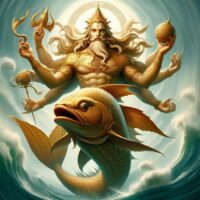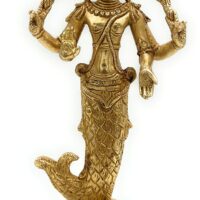Matsya : The Fish Avataar
Listen
At a glance
| Description | |
|---|---|
| Origin | Indian Mythology |
| Classification | Demigods |
| Family Members | N/A |
| Region | India |
| Associated With | Protection, Preservation |
Matsya
Introduction
Matsya, meaning “fish” in Sanskrit, is the first avatar of the Hindu god Vishnu, the preserver. This incarnation represents Vishnu’s divine intervention to protect humanity and restore balance during times of great peril. Matsya holds a significant place in Indian mythology, depicted in ancient scriptures as a fish saving humanity from a great deluge. This story, narrated primarily in the Matsya Purana, one of the eighteen Puranas, symbolizes the preservation of life, salvation, and the beginning of a new cosmic cycle. As one of Vishnu’s ten principal avatars, Matsya is crucial for its themes of salvation, preservation of knowledge, and the cyclical nature of time in Hindu cosmology.
Physical Traits
Matsya is often depicted with a human upper torso and the lower body of a fish, symbolizing a blend of terrestrial and aquatic life. This duality reflects Vishnu’s ability to dominate both land and sea. The human part of Matsya exudes strength and serenity, often with a finely chiseled torso, while the fish part is massive and shimmering with intricate scales. In some representations, Matsya has four arms, two of which hold Vishnu’s typical attributes: the shankha (conch) and chakra (discus), signifying divine authority and protection.
In various texts, Matsya’s depiction varies. Sometimes he is shown as a colossal golden fish, symbolizing his dominion over the aquatic world and his role as the savior during the deluge. Other depictions combine human and fish forms, with the upper body resembling Vishnu and the lower half a fish, emphasizing his divine essence within a fish form. This hybrid form embodies the fluidity and life-giving properties of water, highlighting Matsya’s majestic and awe-inspiring nature.
Family
As an avatar of Vishnu, Matsya is linked to the divine family, which includes Vishnu’s consort Lakshmi and other avatars like Rama and Krishna. Each avatar represents a different aspect of Vishnu, appearing in various yugas (epochs) to accomplish specific tasks. Matsya’s role is deeply embedded in the broader narrative of Vishnu’s incarnations and his interactions with other gods, sages, and beings of the universe.
Matsya’s story prominently involves the sage Manu, regarded as the progenitor of mankind in Hindu tradition. Guided by Matsya, Manu saves humanity and sacred texts from a catastrophic deluge. Although Matsya doesn’t have a biological family of its own, it connects to the larger Hindu pantheon. Vishnu, the preserver, is part of the divine triumvirate alongside Brahma, the creator, and Shiva, the destroyer. In the Matsya myth, Brahma’s creation is threatened by the flood, and Matsya’s act of saving Manu ensures the continuation of the human race, highlighting his pivotal role in the cycle of creation and preservation.
Other names
Matsya is known by various names, such as ‘Matsyendra’ (lord of the fishes) and ‘Matsyaraja’ (king of fishes), reflecting the reverence for his role in mythology. While Matsya is the most widely recognized name, Hindu scriptures also offer other references to the fish avatar. The Shatapatha Brahmana, an early text, mentions a Matsya figure associated with the flood myth without explicitly linking it to Vishnu. The Brahma Purana calls him the “Rohita fish,” referring to a specific carp variety. The Brahmavaivarta Purana, centered on Krishna, identifies Matsya with Krishna, emphasizing the unified essence of the divine.
Matsya’s epithets highlight his divine and salvific roles. Some texts refer to him as “Matsya Avatar,” emphasizing his role as an incarnation of Vishnu, while “Matsyaraja” underscores his supremacy among aquatic beings. These names reflect his unique and revered status within Hindu mythology.
Powers and Abilities
Matsya possesses a wide array of divine powers, including strength, wisdom, and the ability to sustain life, showcasing his role as a protector and preserver during crises like the deluge that threatened King Manu. As an avatar of Vishnu, Matsya embodies immense strength and the ability to navigate both land and sea effortlessly. His large size allows him to carry Manu’s boat through the floodwaters, underscoring his capability to handle immense challenges. Some interpretations even suggest Matsya has the power to manipulate time, given his foreknowledge of the impending catastrophe. In addition to these abilities, Matsya inherits Vishnu’s divine attributes, enabling him to maintain cosmic order and safeguard righteousness.
Matsya’s powers are integral to his role as a savior and protector, evident in his seamless traversal of different terrains and his strength to carry significant loads, such as the sacred Vedas and King Manu’s boat. His ability to foresee and guide Manu through the impending flood highlights his role as a preserver of life and cosmic balance. Matsya’s revelation of the stolen Vedas from the demon Hayagriva underscores his pivotal role in restoring spiritual knowledge and upholding dharma amidst chaos and destruction.
The Matsya myth holds profound significance in Hindu tradition, illustrating Vishnu’s intervention to maintain order in the face of catastrophic events. Matsya’s rescue of Manu ensures humanity’s continuity and the preservation of sacred knowledge, symbolizing the eternal cycle of creation and preservation upheld by Vishnu.
Modern Day Influence
The legend of Matsya has deeply influenced various aspects of Indian culture, spanning temple architecture, dance forms, literature, and religious practices. Its enduring presence continues to inspire contemporary art and spirituality, reflecting the timeless appeal of ancient mythology. Matsya’s narrative, emphasizing themes of preservation, divine intervention, and the cyclical nature of existence, remains integral to festivals and religious ceremonies. In modern artistic expressions, Matsya is a favored subject in paintings, sculptures, and literary adaptations, showcasing moral and philosophical lessons from his story. This includes contemporary media such as books, graphic novels, and animated series, which adapt Puranic tales for broader audiences.
Beyond art and literature, Matsya’s symbolism extends into environmental discourse, resonating with discussions on ecological balance and sustainable living practices. His role in saving species and preserving biodiversity aligns with current efforts to protect endangered wildlife. In the realm of spirituality, Matsya is associated with the Matsyasana (Fish Pose) in yoga, promoting physical flexibility and respiratory health while embodying the balance and fluidity he symbolizes.
In modern times, Matsya’s depiction in sculptures and paintings often includes Vishnu’s characteristic four arms holding divine attributes like the conch shell and discus. His story continues to inspire movements advocating for environmental conservation and knowledge preservation, influencing educational institutions that use Matsya’s image to symbolize their commitment to learning and enlightenment.
Related Images
Frequently Asked Questions
What is lorem Ipsum?
I am text block. Click edit button to change this text. Lorem ipsum dolor sit amet, consectetur adipiscing elit. Ut elit tellus, luctus nec ullamcorper mattis, pulvinar dapibus leo.
What is lorem Ipsum?
I am text block. Click edit button to change this text. Lorem ipsum dolor sit amet, consectetur adipiscing elit. Ut elit tellus, luctus nec ullamcorper mattis, pulvinar dapibus leo.
What is lorem Ipsum?
I am text block. Click edit button to change this text. Lorem ipsum dolor sit amet, consectetur adipiscing elit. Ut elit tellus, luctus nec ullamcorper mattis, pulvinar dapibus leo.
What is lorem Ipsum?
I am text block. Click edit button to change this text. Lorem ipsum dolor sit amet, consectetur adipiscing elit. Ut elit tellus, luctus nec ullamcorper mattis, pulvinar dapibus leo.
What is lorem Ipsum?
I am text block. Click edit button to change this text. Lorem ipsum dolor sit amet, consectetur adipiscing elit. Ut elit tellus, luctus nec ullamcorper mattis, pulvinar dapibus leo.









